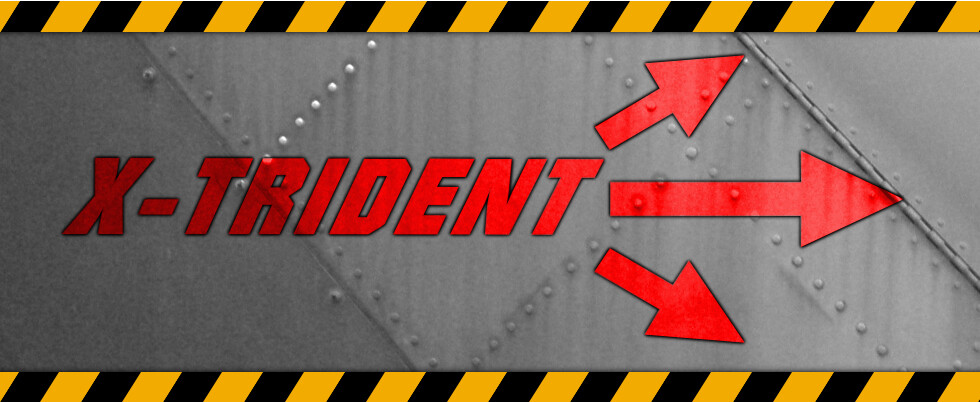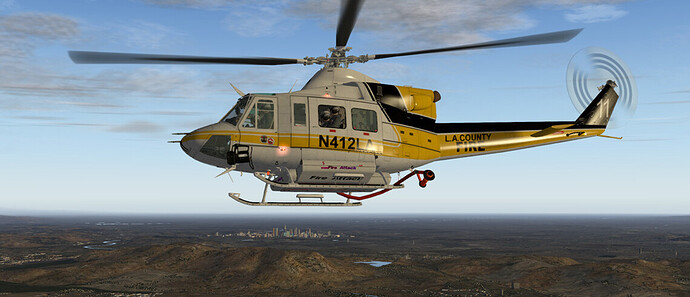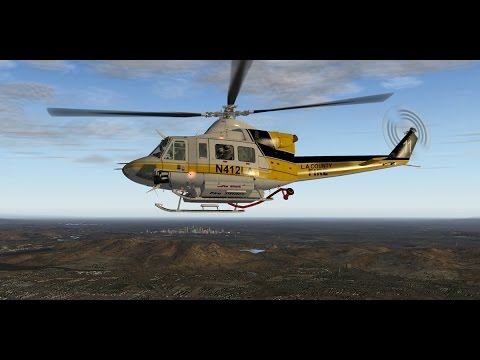X-Trident Bell 412 Review, Q&A, and video!
By @BeachAV8R - January 31, 2015
Originally published at: Articles - Mudspike Forums
 Click on banner to visit X-Trident!
Click on banner to visit X-Trident!
Today we’ll be exploring the terrific X-Trident Bell 412 add-on for X-Plane 10. Plus, the development team agreed to participate in a brief Q&A. As a civil flight sim fan, it makes me extremely happy to see an ever increasing number of quality add-ons being created for X-Plane 10.
Options galore!
The 715MB direct download leaves you with a drag and drop file that you can place in your X-Plane/Aircraft folder. Roughly a dozen liveries are included, but your repaint folder will expand dramatically once you see all the gorgeous custom skins made for the 412. I tried, but it is hard to take a bad screen capture of this beautiful model. A nice feature of the package is that the models have a huge expanse of objects that can be tailored to each skin: spotlights, floats on the skids, skis, door guns, fire fighting modules, assault skids, gyro stabilized cameras, winches, etc. The 3D model is fantastic and the movement of the rotor mast and blades is mesmerizing to watch. Helicopters are ridiculously complex pieces of machinery (often referred to as a bunch of spare parts just flying in close formation) and you get the sense of that with this add-on. There are also some very nice touches added to the package with the inclusion of rotor tie-down straps, a ground power unit, and even a helicopter dolly that can be toggled on and off via a plug-in driven menu.
My personal favorite option that I thought was very creative is the airborne firefighting tanker system that is fully controllable. A switch in the cockpit lowers the pump, hovering over water at the proper height enables filling of the water tank, then you can drop the water onto fires using a toggle switch.
A VC to be seen!
Climbing into the cockpit of the Bell 412 reveals that the beauty is more than skin deep. A nearly fully functional cockpit awaits with stunning details and crisp graphics with excellent readability throughout all zoom levels. One of the nicest features of X-Plane that talented developers are able to take advantage of are the extremely rapid gauge update rates and the very fluid motion of cockpit instrumentation – something the Bell 412 does very well. The textures and depth of the panels and switches is perfect and makes navigating around the cockpit a pleasure when using head tracking gear such as TrackIR. Switches make a satisfying “thunk” when moved although sometimes finding the sweet spot for the click zones can be challenging if your TrackIR is a bit sensitive. Instrument back lighting, cockpit flood lighting, and cabin lighting are all on individual rheostats that are perfectly implemented. Again, X-Plane has a lighting system that is far superior than that of FSX and developers like X-Trident have taken advantage to give cockpit illumination a great sense of “moodiness” that matches what you’d find in real life. Though there are settings for night vision lighting in the cockpit, I think the NVG effect works using X-Plane’s native green shading effect and it isn’t quite as believable as what is displayed in real life (the helo pilots where I work have let me wear their NVGs – and they are really cool!). In the rear cabin, different crew configurations can be selected via a plug-in menu to include gunners, crew members, and a patient. A click on the door handle results in the cabin door sliding open and the noise volume increasing – a nice touch.
Systems and functionality
With most (but not all) of the switches, knobs, and button functional in the Bell 412, at least a minimal attempt at reading the manual is recommended. The manual itself, running 27-pages in length, is fairly good at getting up and running within the sim, but is not as expansive as manuals we’ve seen for other add-ons. Mostly the manual is about detailing the configuration options within X-Plane, checklists, and a few charts, but the document does not go into depth about Bell 412 systems and helicopter flight. The six pages that encompass the start-up checklist are well presented and will get you into the air in a few minutes from a cold & dark cockpit, but beyond that you’ll be expected to have a bit of knowledge about helicopter operations in general to recognize all the features that are included.
The sound effects within the cockpit during the startup, from the initialization of the electrical system to the initial windup of the starters, is very good. The rotor and engine sounds at speed are passable, but I wouldn’t call them overwhelmingly good. I think there could be a little more “chop” to the rotor sound even though it is a four-bladed rotor system. It definitely sounds like a twin engine, four-bladed rotor (and doesn’t sound like a two bladed Huey – nor should it), but to me it just sounds a bit more like an EC-135 than a Bell. I’m open to criticism and correction of my opinion though (keeping in mind that my outfit has operated Bell 206s, 430s, and EC-135s). Other cockpit sounds are very good and the low rotor RPM warning will quickly get your attention.
The start-up is immensely enjoyable as you work your way around the cockpit turning on batteries, fuel pumps, generators, and other items. Once the engines come alive you have a very good feeling of the complexity of flying a modern turbine helicopter – there is a lot to take in! Being a twin-engine helicopter, the Bell 412 has separate gauges and needles for each engine and the start procedure needs to be at least partially duplicated for both engines. The helo includes an artificial stability system (SAS) that veteran helo pilots will recognize and configurable inputs for force trim. The real Bell 412 has a force trim mode that allows for hands free flying, but since most of us are flying with self centering joysticks, a method to trim and allow the stick to reset to neutral is is included and necessary (this will not be new to Black Shark pilots!). Or you can simply fly with the SAS off (not difficult to do) and map traditional trim inputs to something like a coolie hat.
Both left and right side cockpit instrumentation is modeled and each are able to be separately manipulated, which is a nice feature (many sim add-ons simply mirror the left and right instruments for simplicity). The center MFD is able to display radar information or a moving map that is populated by the default X-Plane FMS.
In F-f-f-f-l-l-l-i-i-g-g-h-t-t…
(That’s how rotor pilots sound on the radio in case you were wondering!) Simply put – the X-Trident Bell 412 is an amazing X-Plane experience. Rotor flight in X-Plane is quite good and X-Trident took advantage of that and have provided a real showcase model for the sim. Though I haven’t exhaustively tested the flight model for the lesser noticeable things, there is plenty of readily verifiable feel to the helicopter to make me a believer. Weight is modeled such that more power is required at heavier loads. An interesting and fun demonstration is to start on the runway and shut down one engine, then load the helicopter until it reaches a weight where a hover is not possible. Using that weight, get the helicopter light on the skids and push forward on the cyclic and it is possible to perform a sliding takeoff as the rotor disc gains momentum and enters into translational lift. I was surprised and pleased to see this modeled to good effect. Using the same technique it is possible to perform slide-on landings at weights where a single-engine hover would not be possible. I’m pretty sure I’ve felt the burble of vortex ring state, but it is more understated and less deadly than in some other sims. Anti-torque pedal response feels authentic and varies with available power.
For a really good time, climb to altitude and turn the fuel off to both engines. Bottoming the collective and maintaining about 80 knots provides good rotor RPM, but a steep descent (I never know how helicopter CFIs don’t die of heart attacks when training students in simulated auto-rotations). As you approach the ground, there is usually plenty of stored energy in the rotor disc to perform a good auto-rotation landing by pitching the nose up with the cylic and easing in the collective. If the surface allows for it, a bit of a slide can work for you. Autorotations are exciting and dynamic, and owing to X-Plane’s random failure settings, you never know when it might happen to you.
Autopilot implementation is very good. In my tests, the autopilot and flight director worked as advertised, capturing courses without problem. Shooting a coupled ILS in the soup with a helicopter is very cool and even the go-around can be flown on the autopilot. Manual flying without the stability augmentation is very attainable and either by fault or design the Bell 412 feels very forgiving while retaining the need to be hands on at all times unless you are using one of the autopilot modes.
Conclusion
The X-Trident Bell 412 is one of those stand-out add-ons for X-Plane that really make it clear how far X-Plane 10 has come with regards to graphics, systems, and flight models. Check out our Q&A below and also the short video I created that takes you through a brief start-up, climb, and auto-rotation in the Bell 412.
– Chris “BeachAV8R” Frishmuth
Q&A with X-Trident
Can you give us a brief introduction about who X-Trident is?
The number is in the name of the team, Trident (three). Filippo “Kukuruz”, Pierpaolo “Viper”, and Alberto “x-alberto”. We started some six or so years ago. Filippo was developing the AMX on his own and he was stalled because he needed a plugin. Alberto was experimenting with plugins at the moment. The site admin of x-plane.it put the two in contact and a long friendship started. Close to the end of the development another x-plane enthusiast, Pierpaolo, offered the two to provide, for free, demo videos of the bird. Something was going to happen soon.
What made you choose the Bell 412 to model in such detail?
This was something that Pierpaolo had been working on for a while. He turned to Filippo and Alberto for some minor tuning and coding. Soon we realized the potential of the 412 and we decided to partner into that project. The Trident was born.
Did you have access to an actual Bell helicopter or was the product developed from deep online research?
Online research at the beginning, then a few real pilots came to us with tons of first-hand material (thank you again, guys!).
Your first product was the AMX International fighter back in 2011. The Bell 412 represents a huge leap in terms of cockpit detail and overall quality – how did you make such tremendous strides between releases?
Two main things. First, the AMX was always intended to be a procedural trainer, focused on extended usability rather than top class details. With that in mind, the AMX has still a few “first or unique” in X-Plane’s world (think of the air-to-air refueling, the ground arrest hook, the guided bombs). Also, a lot of attention went into systems modeling and failure modes. Second is… Pierpaolo, the 3D guru of the team. After many years working with him he is still a surprise. He can work so quickly that it takes him less time just to do it then to explain us what he has in mind.
Did you find it difficult to transition from fixed wing aerodynamics modeling to rotorcraft aerodynamics? I understand you enlisted the brilliant Brett S (of X-Plane.org) to assist?
Yes it was difficult. As you probably already know our initial test release received some frustrating comment about the flight model. Not really complaints but it felt like we could have done better. At the time we were using a lot of plugin overrides, and it felt like “not natural” for many. We were pretty satisfied and also feedback from some pilots was positive, but we decided that it was worth improving it. Then, in just a matter of days Brett came to us with a modified model that made everyone happy. It was pretty quick (but not totally painless) to remove the overrides from the plugin. In the end it was a successful move. We also need to credit Ed and Ian for the invaluable input, as well as many other users who helped us with their comments and time. Also special mention goes to livery artists for their add-ons.
Is it your intention to continue developing for the X-Plane platform or could you see X-Trident branching out to include platforms such as FSX and/or Digital Combat Simulator?
It’s not planned. Developing for x-plane is a hobby for us and we are not currently willing to “climb” the learning curve again to move to a different platform.
Rumor has it that your next product may be the Panavia Tornado – if true, can you expand on what types of systems you intend to model and which variant you intend to reproduce?
The Tornado is probably going to be next. It was already in good shape when we put that on-hold to work on the 412. We are not sure what the exact variant will be. In terms of systems we already have the moving maps done. Next will be the terrain avoidance radar. We still need to define the exact scope.
Are there challenges or advantages to developing for the X-Plane platform given the frequent update patches to the X-Plane base product?
We think new features outrank the cost of fixing for the broken ones. Yes, it can be frustrating sometimes but support from Laminar is great. For the 412 we needed a new dataref – we got it in 2 days.
Besides the Tornado does the team collectively have any other “dream” planes that it would like to develop for X-Plane?
Maybe the Venom or the AV-8B. Alberto is really pushing for the Space 1999 Eagle Transporter but we are trying to keep him sedated quiet.
Is there any hope that X-Plane may eventually evolve into both a civil and combat flight simulation based on X-Trident’s penchant for developing military aircraft add-ons?
In order to reach that I think developers should team up to devise a common strategy. I’m not sure how feasible this can be. Coordination efforts can be huge.
Thanks to the crew at X-Trident for participating in our Q&A – we look forward to even more great things from their small development house. If the AMX and Bell 412 are the barometers for success, I think we will have a storm of great content coming down the pipe from these extremely talented guys. Link to product purchase/info site: HERE!



























